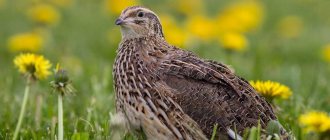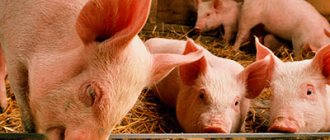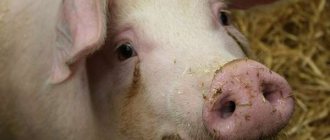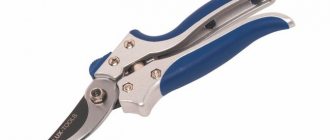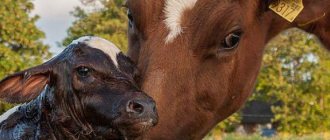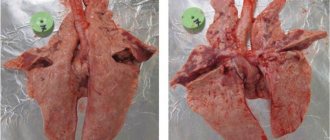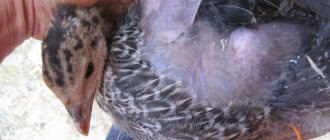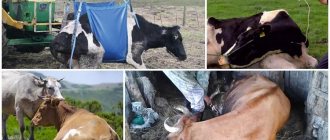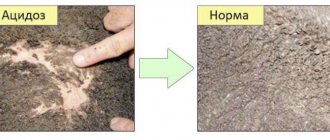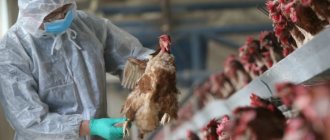Multiparous animals, which include pigs, often suffer from congenital or acquired pathologies, so breeders often have a problem when a boar has a hernia in the testicle. Our article will tell you what to do in this case. In addition, we will help you deal with all other types of this pathology, because it can manifest itself in other parts of the body of pigs, regardless of gender and age.
The concept of hernias
A hernia most often appears in young piglets; in adults, this disease is recorded very rarely. Pathology is the displacement of internal organs under the skin or to other parts of the body. The attack can be congenital or acquired.
Congenital hernias in pigs appear due to improper intrauterine development of the fetus or when sows had a difficult birth. Acquired pathology can occur a few days after the baby is born.
The cause of the disease is high intra-abdominal pressure. There are cases when a pig's blood pressure normalizes on its own and the hernia disappears. However, this phenomenon does not occur as often as we would like, so breeders rarely hope for luck.
Umbilical clamp for the conservative treatment of umbilical hernias in gilts 10-15 days of age
Tatyana Chornozub Candidate of Veterinary Sciences Scientific consultant UKRVET LLC
A hernia is the displacement of internal organs into cavities located nearby, or under the skin, through natural or artificial openings, along with the parietal peritoneum (the serous membrane lining the abdominal cavity).
There are many reasons for the occurrence of umbilical hernias in piglets. The recessive type of inheritance of umbilical hernias has now been proven. However, in most cases, important etiological factors are also a rough break of the umbilical cord without preliminary fixation near the abdominal wall, mechanical injuries, increased intra-abdominal pressure due to constipation or diarrhea, and low fatness of the young. At the same time, in newborn piglets, the umbilical ring expands both during the struggle between themselves during sucking and during crawling through low holes. Mechanical injury to the umbilical ring leads to divergence of its edges and protrusion through the enlarged opening of the peritoneum and internal organs - omentum, intestinal loop, etc. In this case, a soft, elastic and painless protrusion appears in the navel area. At the same time, when organs are pinched in the area of the umbilical ring, tension, pain and an increase in local temperature are observed. Piglets may experience constipation and vomiting. Often, umbilical hernias are a consequence of a disruption in the course of pregnancy in sows or a difficult birth. Sometimes umbilical hernias appear after birth, in the first days of life of piglets, which is associated with increased intra-abdominal pressure due to various causative factors. Sometimes, within a few days, intra-abdominal pressure decreases and the umbilical hernia may disappear on its own.
Hernia piglets lag behind their “brethren” in growth by about 10 kg in the first 2-3 months. At the same time, the presence of a hernia spoils the marketable appearance of the animal, and therefore, when slaughtered, such pigs lose up to 20% of their value.
Pigs that are growing or fattening very often injure their hernial sacs from blows and stepping on the limbs of other animals, biting the hernia by other piglets, and sliding on the floor while walking, which most often leads to the death of the animal.
A reducible hernia is characterized by the free and painless movement of the contents of the hernial sac through the hernial opening into the natural cavity. In this case, the contents of the hernia are soft and elastic, easily palpated and reduced into the hernial opening.
Currently, to effectively eliminate non-strangulated umbilical hernia in hernia-bearing piglets, a conservative treatment method has been tested, which is carried out using special clamps. The latter are made of high quality elastic but dense plastic with a length of 6 cm.
In this case, the contents of the hernia are pushed into the abdominal cavity, and a special plastic clamp is applied to the surface of the skin of the empty hernia sac. It is applied only to pigs at 10-15 days of age . The duration of loss of the hernial sac due to necrosis of skin tissue is approximately 14 days. Thanks to the structure of the clamp, a smooth connective tissue scar is formed at the site of death of the skin of the hernial sac.
A positive result is observed in 99.9% of cases when this method is used. Subsequently, after the hernial sac fell off and the clamp was removed, there were no cases of umbilical hernia formation, that is, relapses. This indicates the high effectiveness of such a simple and easily accessible conservative method of treating umbilical hernia in pigs.
Classification of pathologies
Hernias in boars and pigs are classified according to several criteria and differ in certain indicators. They can be umbilical, perineal and inguinal.
The disease is classified into several groups. The most difficult thing is the lack of options for hernia reduction. In other words, is it possible to treat the pathology or do boars need to be castrated and gilts released for meat at a certain age.
Congenital hernias appear in young individuals at birth or a few days after the start of life (2-3 days). Acquired pathologies are less common, and they are often caused by injuries that were inflicted on the animal intentionally or involuntarily. The pigs can get hit by:
- stakes or other objects (most often a person is to blame for this);
- when falling under a feeder or into a pit;
- during a fight with relatives.
Hernias in piglets and adult pigs are also classified according to the condition of the contents. Reducible hernias are mobile, that is, the formation can be displaced by palpation without causing pain to the animal. The breeder may notice a small pouch that is covered with skin, usually in the inguinal or abdominal cavity.
Irreducible formations are considered very dangerous; hernias do not move and the pig experiences pain when pressing on them.
Pigs with an irreducible hernia are most often slaughtered as soon as the animal gains a weight of 20-30 kg, because such an individual runs the risk of dying before reaching puberty. Piglets die due to the fact that their relatives become interested in the seal on the body of the sick animal.
A strong blow is almost always fatal.
A NEW METHOD FOR HERNIATION IN PIGS
In increasing the efficiency of fattening, along with proper care and feeding, new technologies that increase productivity play an important role. When they are violated, various diseases arise, especially often intravaginal hernias in piglets, which causes great economic damage.
At the Department of Surgery of the Ural State Academy of Veterinary Medicine, a new method of hernia repair in piglets has been developed, leaving the testis in the scrotal cavity.
Before surgery, the animals were kept on a 12-18-hour fasting diet. During hernia repair, the boar was fixed on its back with its head down. The surgical field was prepared according to the rules of surgery and infiltration anesthesia, introducing a 0.5% solution of novocaine, and neuroleptics were also administered to the older group of piglets.
An incision 6-8 cm long was made in the groin area opposite the external inguinal ring to the common vaginal tunica. The latter was separated from adjacent tissues. Subsequently, its contents (most often intestinal loops) were inserted into the abdominal cavity. At a distance of 1.5-2 cm from the external inguinal ring, a ligature made of silk or synthetic thread was placed under the common vaginal membrane. The second ligature was also placed under the membrane with the spermatic cord. The inner part of the shell, together with the spermatic cord, was twisted, and the free ends of the ligature were alternately pulled with a needle through the outer and inner edges of the ring and tied with a knotted suture. With a large inguinal ring, two or three additional stitches were made. After treatment with an antiseptic drug, the skin wound was sutured with the same suture.
Deprived of innervation and blood supply, the testis becomes a biologically active tissue preparation. Metabolic products of cellular proteins and nucleic acids that accumulate in its tissues contribute to the normalization of higher nervous activity. Immunological reactions, regeneration processes and erythropoiesis are stimulated, metabolism and vital activity of the body as a whole are improved, which helps to increase the live weight of the operated piglets.
To conduct the experiment, two groups of animals of three heads each were formed.
In the 1st group, the piglets underwent hernia repair, leaving the testis in the scrotal cavity; in the 2nd group, the operation was performed according to the generally accepted method. The slaughter yield of carcasses in the 1st group averaged 78.9 kg, in the 2nd group - 69.5 kg, the thickness of the backfat in the withers area was 4.3 and 3.4 cm, respectively, in the chest wall area - 1, 5 and 0.6 cm. The length of the half carcass from the junction of the first rib with the sternum in the 1st group is 84, in the 2nd - 77 cm. The weight of the skins is 6.9 and 6.8 kg, respectively. The average weight of meat is 46.6 and 36.8 kg, bacon - 14.5 and 13.4 kg, connective tissue - 8.2 and 8.6 kg, bones and cartilage - 9.1 and 11.5 kg.
According to organoleptic data, the meat and lard of both groups complied with GOST. Both samples were of high quality in color, consistency, smell and taste. According to biochemical indicators, the fat and protein content in meat of the 1st group was higher, and the water and ash content was lower than in the 2nd group. The calorie content of pork of the 1st group is 498+1.5%, 2nd - 487.8+0.6%, bacon - 842.6+2.1 and 839-0.2%, respectively.
Umbilical hernia
As a rule, umbilical hernias appear in 2-3% of the total pig population. Animals suffering from this disease can be recognized by any experienced breeder, because the hernial sac is immediately visible on the body, in addition, such individuals do not gain weight well and often get sick. Often these piglets are either rejected or they themselves die due to strangulation of the hernial contents.
Most often, umbilical hernia occurs in boars, but pigs in some cases also suffer from this disease. This pathology is treated in a bloody and bloodless way.
The first method of getting rid of the disease involves surgical intervention - the formation is removed. In bloodless treatment, the contents of the hernial sac are reduced. All actions can be performed exclusively by a qualified veterinarian.
It is noted that in most cases, treating pigs with such pathology is unprofitable, since the probability of a relapse is 50%.
Hernia treatment
If the owners notice a hernia in the piglet on the stomach or in the groin area, they should immediately contact a veterinarian, as he will explain how to treat it and what actions the owners should take simultaneously with the treatment provided at the veterinary clinic. If an enlarged hernia is constantly injured or the piglet actively touches it while playing or rolling on the floor, this can lead to death, so treatment should be started as early as possible. First of all, the pig will undergo surgery. During this procedure, the veterinarian will remove the contents of the hernial sac. The bag itself can also be removed or inserted into the abdominal cavity (for an umbilical hernia). Then the hernial opening and the surgical incision on the skin are sutured, and stitches are applied. The operation in veterinary clinics is performed using general anesthesia or local anesthesia, so that the piglet will not feel pain.
The pig will need post-operative care, which will also be prescribed by a veterinarian. In addition, a special diet may be recommended depending on the severity of the surgery. You should only contact certified veterinary clinics to treat a piglet's hernia, as this is a rather complex operation. But even after it, a good doctor may have the hernia reappear. All these factors, unfortunately, can significantly shorten the life of a piglet.
Groin seals
Scrotal hernia occurs in male piglets and is considered the second most common. Most often, the disease is acquired and occurs when a certain muscle group of the animal is strongly compressed (for example, during a fight between young animals).
The breeder is not able to treat such a disease on his own, so he always has to seek help from a veterinarian. The profitability of performing manipulations is difficult to determine, since the doctor in most cases will suggest that the boar be castrated.
Castrated boars are also fattened and slaughtered at the appropriate time. They cannot cover pigs. At the same time, castration is considered a fairly quick process; the animal comes to its senses within a few hours after the procedure and continues to lead its usual lifestyle.
If the information from the above text was useful to you, then be sure to share the link to the article with your friends.
If you are a pig breeder and, based on personal experience, can give advice regarding the treatment of hernia in pigs, then be sure to express your opinion in the comments.
Hernia in piglets: types, symptoms, treatment
A hernia in piglets is a displacement of organs along with the inner part of the peritoneum under the skin or into other body cavities. A hernia has its own structural elements - the hernial opening, the hernial sac and the hernial contents. There is a certain classification to designate this pathology.
Initially, hernias are classified according to their anatomical location: umbilical, inguinal, perineal. Further, hernias are distinguished according to their cause: congenital, acquired. And the last classification of hernias is based on the state of their contents. There are reducible, irreducible and strangulated hernias.
Hernia piglets lag behind their brothers in growth by about 10 kg in the first 2-3 months. A hernia spoils the marketable appearance of the animal and, when slaughtered, such a pig loses up to 20% of its value. Most owners do not allow such piglets to grow up, and send them to slaughter when they reach 20 or 30 kg. Fattening pigs very often injure their hernial sacs (kicking, rolling on the floor, interest of relatives in the hernia), which often leads to the death of the animal.
Among multiple-fetal animals, such as the pig, the most common is umbilical hernia in piglets. The hernial opening here is the umbilical ring, the sac is part of the peritoneum, and the contents are the omentum. If the hernial opening is quite large, then in addition to the omentum, intestinal loops may fall out. Most often, umbilical hernias are congenital; this is due to disruption of pregnancy in sows and difficult childbirth. Sometimes umbilical hernias appear after birth in the first days of life of piglets. This phenomenon is associated with increased intra-abdominal pressure. Within a few days, intra-abdominal pressure disappears and the umbilical hernia may disappear on its own, but this does not occur as often as we would like.
The second most common is inguinal hernia in piglets. It occurs in boars. The common tunica vaginalis, which encloses the boar's testes, is a continuation of the inner layer of the peritoneum. In addition, the abdominal cavity and testes communicate through the spermatic cord, which passes through the inguinal rings. Compared to umbilical hernias, inguinal hernias are less common. They are mostly acquired and occur when the abdominal wall is strained. Active movements and fights among piglets strain all muscle groups, and with congenital wide inguinal rings, an inguinal hernia is just a stone's throw away. The hernial opening is the inguinal rings, the sac is part of the abdominal wall, and the contents are the omentum or intestinal loops.
Inguinal hernias are a pathology not only for males, but also for females. Inguinal hernias occur in female fur-bearing animals or dogs. Among pigs, this type of hernia is very rare, but it does happen. For a more precise classification in piglets, the following definitions are used: inguinal hernia, used for gilts; inguinal-scrotal hernia in piglets, used for boars.
A hernia has appeared in piglets, treatment is carried out by a veterinarian. In the case of an inguinal-scrotal hernia in a boar, it can be removed by castration and suturing of the inguinal rings. Animals with an umbilical hernia are fed to an acceptable slaughter weight. Surgical treatment of such hernias is not economically profitable. Relapses occur in 50% of cases. It is also not economically profitable to treat strangulated hernias.
Conservative methods of treating hernias have been known for a long time. This is the application of all kinds of bandages, tight bandages, adhesive plaster. Some owners try to charm the hernia by performing various mystical rituals. But the effectiveness of these methods has not been proven and only causes a smile in the scientific world.
